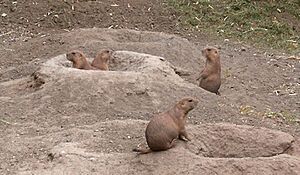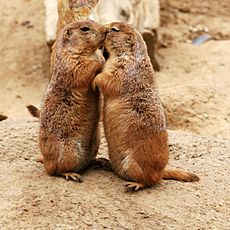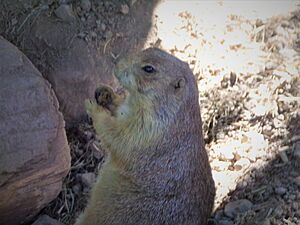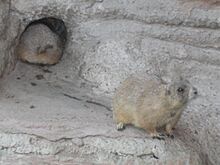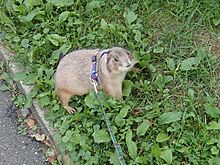Prairie dog facts for kids
Quick facts for kids Prairie dog |
|
|---|---|
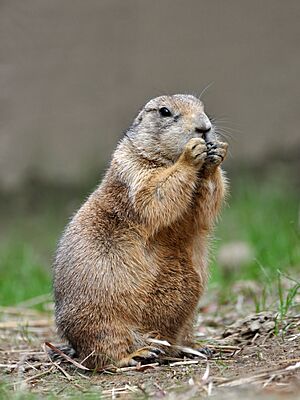 |
|
| Black-tailed prairie dog at the Smithsonian National Zoo Park in Washington, DC | |
| Scientific classification |
|
| Kingdom: | Animalia |
| Phylum: | Chordata |
| Class: | Mammalia |
| Order: | Rodentia |
| Family: | Sciuridae |
| Tribe: | Marmotini |
| Genus: | Cynomys Rafinesque, 1817 |
| Type species | |
| Cynomys socialis Rafinesque, 1817
(= Arctomys ludoviciana Ord, 1815) |
|
| Species | |
|
Cynomys gunnisoni |
|
Prairie dogs are a type of ground squirrel. They live in burrows, which are underground tunnels. You can find them in the grasslands of North America.
Contents
- Where Do Prairie Dogs Live?
- Why Are They Called Prairie Dogs?
- What Do Prairie Dogs Look Like?
- How Long Do Prairie Dogs Live?
- What Do Prairie Dogs Eat?
- Prairie Dog Homes and Burrows
- Prairie Dog Social Life
- Prairie Dog Reproduction and Life Cycle
- How Prairie Dogs Protect Themselves
- Threats to Prairie Dogs
- Why Are Prairie Dogs Important?
- Prairie Dogs in Captivity
- Interesting Facts About Prairie Dogs
- Images for kids
- See also
Where Do Prairie Dogs Live?
Prairie dogs live in countries like the United States, Mexico, and Canada. Most of them live west of the Mississippi River. Some have been moved to other areas.
Why Are They Called Prairie Dogs?
Prairie dogs get their name from two things. First, they live on the prairie, which is a large grassland. Second, they make a barking sound. This sound warns other prairie dogs when danger is near. People started calling them prairie dogs a long time ago, in 1774!
Even famous explorers like Lewis and Clark wrote about them. In 1804, they called them "Prairie Dogs" in their journals. Some Native American tribes also have special names for them. For example, the Lakota people call them "pispíza" or "pìspíza."
What Do Prairie Dogs Look Like?
Prairie dogs are small, chubby animals. They have short tails. They are usually about 12 to 16 inches long. They weigh between 1 and 3 pounds. Male and female prairie dogs can be different sizes. This depends on their specific type.
How Long Do Prairie Dogs Live?
In the wild, prairie dogs usually live for about 8 to 10 years.
What Do Prairie Dogs Eat?
Prairie dogs are mostly herbivores. This means they eat plants. They love to eat grasses and small seeds. Sometimes, they might also eat insects.
In the fall, they eat broadleaf plants. In winter, female prairie dogs eat snow for water. They also eat roots, fruits, and buds. Different types of prairie dogs eat different foods. For example, black-tailed prairie dogs in South Dakota eat bluegrass. They also eat blue grama and buffalo grass. Gunnison's prairie dogs eat rabbit brush, tumbleweeds, and dandelions. Sometimes, white-tailed prairie dogs have even been seen eating ground squirrels!
Prairie Dog Homes and Burrows
Prairie dogs live in grasslands that are high up. These areas are usually between 2,000 and 10,000 feet above sea level. The weather there can be very hot in summer. It can also be very cold in winter.
Their homes protect them from bad weather. This includes hailstorms, blizzards, and floods. Burrows also help them stay warm in winter. They keep them cool in summer.
Prairie dog tunnels help rainwater soak into the ground. This stops the soil from washing away. It also helps the soil stay healthy.
Prairie dog burrows are usually 16 to 33 feet long. They are 6.6 to 9.8 feet deep. The holes are about 4 to 12 inches wide. Some burrows have mounds of soil around them. These mounds help them see predators. They also keep water out of the burrow.
Prairie Dog Social Life
Prairie dogs are very social animals. They live in large groups called "colonies" or "towns." These towns can cover hundreds of acres. The basic unit of their society is the family group. Members of a family group live in the same area. They interact by touching noses, which looks like "kissing." They also groom each other. They do not do these things with prairie dogs from other families.
A typical prairie dog family territory is about 0.05 to 1.01 hectares. These territories have clear borders. These borders often follow natural things like rocks and trees. The male prairie dog living in a territory defends it. Males from different families will fight to protect their areas. These fights can happen 20 times a day. They can last for five minutes. When two prairie dogs meet at the edge of their territories, they stare. They might also make fake charges. They flare their tails and chatter their teeth. They also sniff each other. When they fight, prairie dogs bite, kick, and ram each other. If the other prairie dog is their size or smaller, females will join the fight. If a bigger competitor is seen, the females will call for the male.
Prairie Dog Reproduction and Life Cycle
Prairie dogs mate inside their burrows. This keeps them safe from animals that might hunt them.
Female prairie dogs take care of the babies. They feed them milk and protect them. They also gather grass for their nests. Male prairie dogs protect the territory. They also take care of the burrows.
Baby prairie dogs stay underground for their first six weeks. After that, they start to come out of the burrow. By the time they are five months old, they are fully grown. Sometimes, prairie dogs will even take care of babies that are not their own.
How Prairie Dogs Protect Themselves
Prairie dogs are very good at staying safe from predators. They have excellent eyesight. They can see predators from far away. When they spot a predator, they make a special barking sound. This warns the other prairie dogs.
Scientists think prairie dogs have a special language. They use it to describe different predators. They can tell others what the predator is. They can also say how big it is and how fast it is moving.
When they hear an alarm call, prairie dogs react differently. If the alarm is for a hawk, they dive into their holes. If it's for a human, they all run inside their burrows. If the alarm is for a coyote, they stand at the burrow entrance and watch it.
Scientists are not sure if these calls are just to protect themselves. They might also be meant to confuse predators.
One interesting thing prairie dogs do is the "jump-yip." A prairie dog will stretch its body up. It throws its front paws into the air while making a call. When one prairie dog does this, others nearby will do the same.
Threats to Prairie Dogs
Prairie dog homes have been affected by humans. Farmers sometimes remove them. Also, cities and towns are growing into their habitats. This has greatly reduced their numbers. Removing prairie dogs can cause problems. It can lead to unwanted growth of brush. The cost of this to livestock land and soil quality can be more than the benefits of removing them. Diseases are another threat. Prairie dogs are now protected in many places. This helps keep their populations healthy. It also helps natural ecosystems.
Why Are Prairie Dogs Important?
Prairie dogs are a keystone species. This means they are very important to their environment. Their mounds are often used by other animals. Their burrowing helps grass grow. It also helps renew the topsoil. This adds rich minerals and nutrients to the soil. This is very important for soil quality and farming.
They are also a key part of the food chain. Many animals eat prairie dogs. These include the black-footed ferret, swift fox, golden eagle, red tailed hawk, American badger, and coyote. Other animals also rely on prairie dog burrows for nests. These include the golden-mantled ground squirrel, mountain plover, and the burrowing owl. Grazing animals like plains bison, pronghorn, and mule deer like to eat grass in areas where prairie dogs live.
Prairie Dogs in Captivity
Sometimes, people keep prairie dogs as pets. However, they can be hard to care for. They need a lot of attention. They also need a special diet.
In the past, many prairie dogs were taken from the wild to be sold as pets. But now, this is illegal in many places. This is because they can carry diseases.
In 2003, there was a monkeypox outbreak. It happened in pet prairie dogs. This led to a ban on selling and moving prairie dogs in the United States. The ban was lifted in 2008. However, some states still have their own bans. The European Union still bans importing prairie dogs from the United States.
Prairie dogs in captivity can live up to 10 years.
Interesting Facts About Prairie Dogs
- Their scientific name, Cynomys, means "dog mouse" in Greek.
- The explorers Lewis and Clark sent a prairie dog to President Thomas Jefferson. He found it quite strange!
- Prairie dogs have special rooms in their burrows. They have nursery rooms for babies. They have rooms for sleeping at night. They also have rooms for winter. They even have air chambers. These might protect the burrow from floods. They also might be listening posts for predators.
- A prairie dog town can have 15–26 family groups. These groups can have smaller subgroups. These subgroups are called "wards." They are separated by physical barriers.
Images for kids
-
Skeleton of a black-footed ferret (Mustela nigripes) with a prairie dog skeleton, articulated to show the predator-prey relationship between them. (Museum of Osteology)
See also
 In Spanish: Perritos de las praderas para niños
In Spanish: Perritos de las praderas para niños


